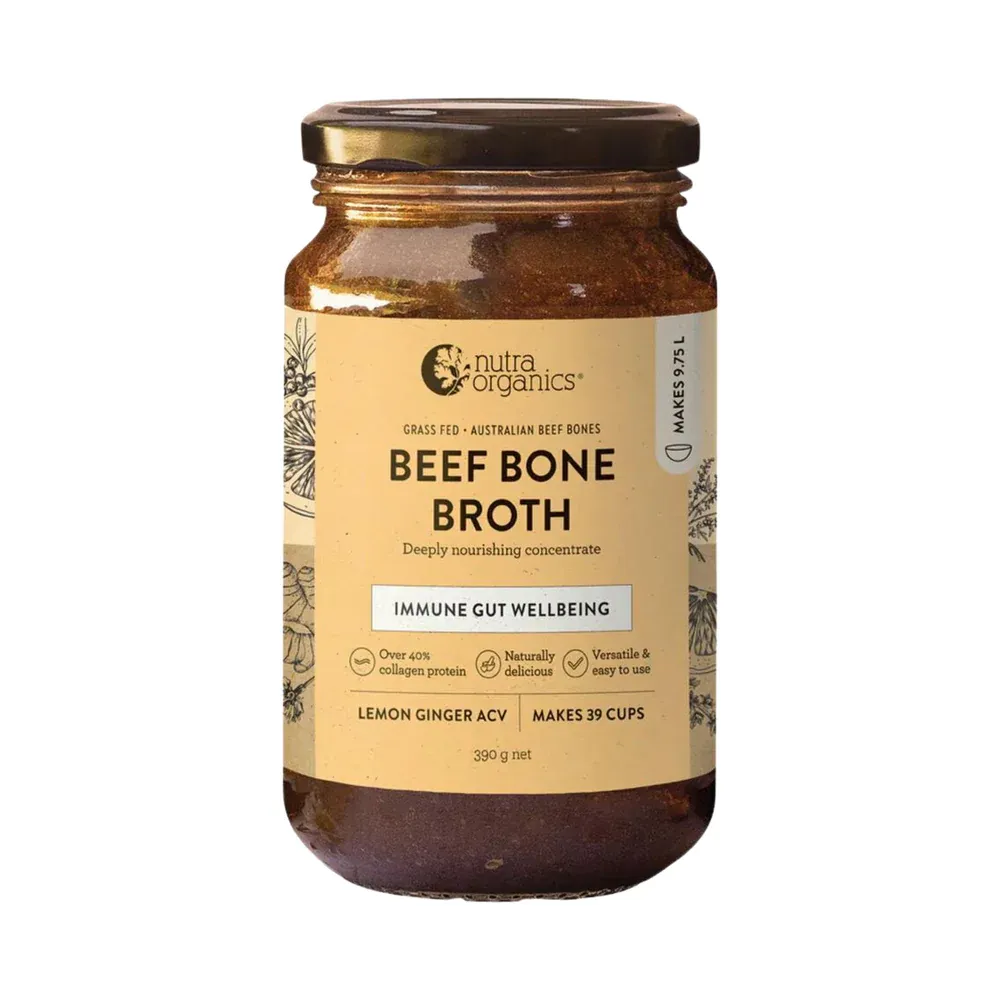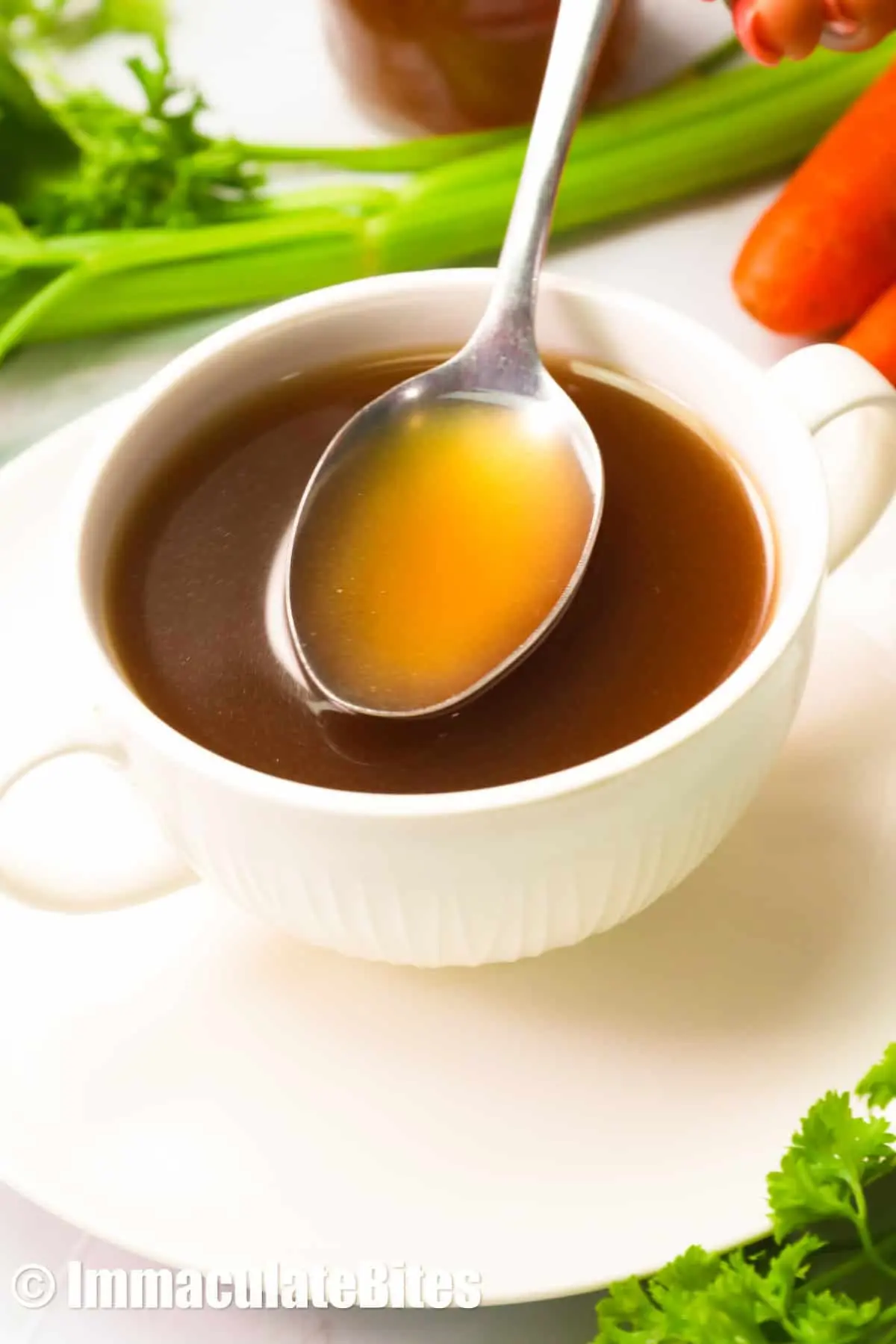Back
'Bone broth' are two little words that have been dominating the health world for a while now.
Haven't you heard? All the cool kids are sipping on it! But, unlike other wellness trends that come and go, you best believe that bone broth
A) is not a fad
and
B) is here to stay.
Here, we start with the basics and work our way through how you might benefit from bone broth, the difference between Bone broth and stock (hint: A LOT!) and how you can incorporate it into your daily diet.

What is bone broth?
Bone broth is typically made from the bones of beef, lamb, chicken or fish, simmered on low for a long period of time (often between 12-24 hours). This process allows for the release of nutrients including gelatin, collagen, amino acids and a number of vitamins and minerals, resulting in an incredibly nourishing broth that is great for overall health and wellbeing and in particular, can help support your gut. Bone broth usually comes in the form of either a liquid or concentrate - both equally beneficial, however, you can usually spot a good quality bone broth if it has the following things:
- 12-24 hour cooking time
- Grass-fed beef where possible
- Low salt content
- Certified organic where possible
The benefits of bone broth:
- Aids digestion:
Bone broth stimulates the release of digestive juices needed to break down food whilst also assisting with the production of bile acids required to break down fats. The nutrients in the broth also help to maintain a healthy balance of bacteria that live in our gut which also play a key role in digestion among many other things.
- Protects the gut lining:
The amino acids glycine and proline are important structural components of the connective tissue that lines the digestive tract. The gelatine found in bone broth aids in the protection and healing of the mucosal lining of the digestive tract which helps address conditions such as leaky gut, a term used to describe the increased permeability of the intestinal wall which allows for bacteria to translocate into the bloodstream and disrupt digestion.
- Strengthens immunity:
Did you know that 80% of the immune system is located in the gut? Yep! Both the gut microbiota and the immune system are intimately related, so it’s important to look after one for the other! When there’s an imbalance of good and bad bacteria in the gut, our immune systems have to work that extra bit harder to fight to keep our bodies healthy.
- Reduce inflammation:
Bone broth is rich in hyaluronic acid, glucosamine and chondroitin compounds which are important for joint health and reducing inflammation-associated conditions such as osteoarthritis and rheumatoid arthritis. Glucosamine can actually help stimulate the growth of new collagen and repair damaged joints.
- Supports healthy skin, hair and nails:
Collagen is the most abundant protein present in the human body and responsible for the maintenance of youthful-looking skin, healthy hair and strong nails. As bone broth is full of collagen (and gelatin) it works to support all of the above!

Bone broth vs. stock:
Bone broth and stock are two very different things. As we’ve learnt, the process of making bone broth allows for the retention of amino acids, vitamins and minerals that are drawn out from bones, making it a highly nutritious option.
On the other hand, many stocks you’ll find in the supermarket (including beef, fish and chicken stock) more often than not aren’t made from meat at all. This means that you're not receiving the same benefits as you would by consuming bone broth.
These stocks are lower in nutritional value and in addition to this, the stock that we generally find on supermarket shelves contains added preservatives for extended shelf-life and flavour enhancers such as MSG. They are usually often loaded with salt and sodium as well.
Don't fear, there is a heap of great stocks ranged at GoodnessMe, including both vegetarian and plant-based options. From San Elk to Urban Forager, you can rest assured of finding a stock for your dietary requirements or health concerns. Urban Forager also has a great range of low-FODMAP options.

How to use bone broth:
One of the easiest way you can enjoy bone broth is simply as is. Liquid varieties can just be heated, or, if it’s a concentrate or paste, simply just require the addition of boiling water. You'll notice that bone broths turn a milky white colour when mixed with water — this is totally normal! It's just all the nutrients doing their thing.
If you’re new to bone broth and still getting used to the taste, it also makes for a great base for homemade soups, risottos, bolognese, casseroles or any other of your favourite savoury dishes!
Have fun in the kitchen and enjoy tasty and delicious benefits of Bone broth!

